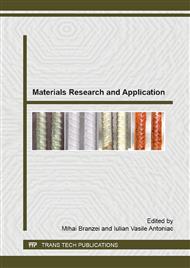p.155
p.160
p.166
p.172
p.183
p.190
p.196
p.206
p.214
The Effect of Ce Added to Carburizing Paste on Phase Composition of Carburized Surface Layers
Abstract:
Investigations on carburized layers phase composition are usually made by optical microscopy, electron microscopy and X-ray diffraction. A microstructure consisting in different proportions of superior bainite, inferior bainite, martensite and retained austenite was found after carburizing in paste of the 21NiCrMo2 steel which has appropriate bainitic hardenability. The investigations carried out on 21NiCrMo2 steel samples, carburized in paste with additions of about 10% Ce, highlighted a significant change of phase proportions ratio in the carburized layer resulting in an important increasing of the lower bainite ratio. It was also observed, that the carburized layer case depth obtained in the carburizing paste with Ce additions does not significantly differ in relation to that attained in the carburizing paste without Ce additions but the microhardness increases considerably. The reason is connected also to the presence of Ce carbide identified by X-ray diffraction in the carburized layer. The Ce hard affinity towards oxygen and its influence on bainitic hardenability increasing is well known and adopted, however neither Ce transfer mechanism from carburizing paste to the carburizing layer and nor the effects of its high affinity to oxygen (for example) are not addressed in this particular case. The present study proposes a possible transfer mechanism of Ce in the carburized layer and an explanation of the consequences of Ce hard affinity towards oxygen on the phase composition of the carburized layer. Nanoscale iron oxides such as wüstite, magnetite and maghemite were identified in the surface of the carburized layer by Mössbauer spectrometry.
Info:
Periodical:
Pages:
183-189
Citation:
Online since:
July 2015
Authors:
Keywords:
Price:
Сopyright:
© 2015 Trans Tech Publications Ltd. All Rights Reserved
Share:
Citation:


